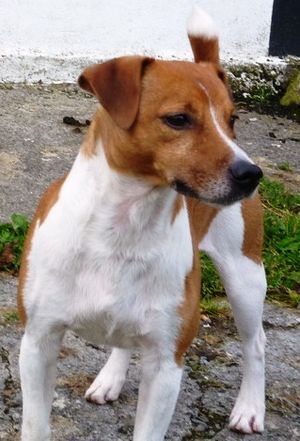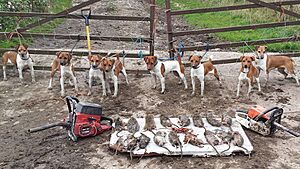Plummer Terrier facts for kids

Plummer Terrier
|
|
| Origin | United Kingdom |
|---|---|
| Breed status | Not recognized as a standardized breed by any major kennel club. |
| Notes | PTCGB breed standard |
| Domestic dog (Canis lupus familiaris) | |
The Plummer Terrier is a special type of working terrier. It was first created by Dr. David Brian Plummer to help hunt small animals like rats. Even though big dog clubs don't officially recognize this breed, Plummer Terriers are known for being super tough and determined.
Contents
How the Plummer Terrier Began
In the 1960s and 1970s, a man named Brian Plummer was a teacher in England. He was already well-known for hunting rats with his group of terriers. He decided he wanted to create his own unique dog breed.
Plummer was good at breeding dogs. He mixed different breeds like the Jack Russell Terrier, the Beagle, the Fell Terrier, and the Bull Terrier. His goal was to create a strong, reliable terrier that was great at its job.
These new terriers worked very hard. As the breed grew, so did Plummer's fame for creating tough dogs that looked and acted consistently. At first, they were called the Huddlesford Rat Pack, but now they are named after him.
Over time, other dog lines were added to make the breed even better. For example, some Beagle blood was introduced from a special show dog line. Also, working Fell Terrier lines were added, which helped improve their shape and make them look more like the Plummer Terrier we know today. Important dogs like Pagan, a black and tan terrier, were key to developing the breed.
Other additions included specific Jack Russell terriers and even some foxhounds. These dogs were known for being excellent at working underground, which is a very important skill for terriers.
In the early 1980s, Brian Plummer even appeared in TV shows about him and his dogs. He said he hoped one day his terriers would be officially known as Plummer Terriers and recognized by the Kennel Club.
In 1985, Plummer became very ill. He had to give his many dogs to friends. Later, he moved to Scotland and started writing full-time. By the early 1990s, many of his original dogs were brought back together. This helped continue his work and widen the breed's family tree to keep them healthy.
At this point, two slightly different types of Plummer Terriers started to appear. One was smaller with a more pointed nose, and the other was stronger with a bigger head. Plummer preferred the stronger-headed type. In the late 1990s, he added some Bull Terrier blood to the breed to make them even stronger and healthier.
Brian Plummer passed away in 2002. But his work was carried on by others, and the breed's standards are still followed today.
Plummer Terriers are very useful dogs. They are good at fetching things, often love water, and are smart. They have excellent noses and are easy to train. They can be used for many tasks, like hunting with ferrets or helping on hunting trips. Most often, they are used in groups to hunt rats.
What do Plummer Terriers Look Like?
The Plummer Terrier is a striking dog. They usually have a bright, fiery red coat with white markings. There are two main patterns for their white markings:
- Collared: They have a white band around their neck.
- Caped: They only have white on their throat, with the rest of their body being red.
They should have a lot of color and usually stand no taller than 14 inches (about 35 cm) at the shoulder. Dogs that don't have these clear white markings are called "shattered." They are still great pets and workers, but they aren't considered the best examples of the breed's looks. The same goes for "tricolours," which are dogs that have black in their coat.
Their ears fold over, like most terriers. Their nose and eyes are typically black, and their jaw has a strong "scissors bite," meaning their upper teeth fit perfectly over their lower teeth.
How a Plummer Terrier Should Be
Brian Plummer set a standard in 2000 for what a Plummer Terrier should be like.
- Overall: They should be strong, tough, active, and able to adapt to different situations. They are true terriers. They should be comfortable living inside a house or in a kennel. They are very smart, brave, and determined. They are loving, loyal, and trustworthy with their family and friends. They should look bright and alert, but not overly aggressive or nervous.
- Head: Their head should be medium-sized and strong, with powerful cheek and jaw muscles. A slight resemblance to a Bull Terrier is good, and they should have a clear "stop" (the area where the forehead meets the muzzle).
- Ears: Their ears should be folded over, rounded, and lie neatly against their head. Ears that stand up or are "rose" shaped (folded back) are not preferred.
- Eyes: Their eyes should be dark, stand out a bit, be oval-shaped, and set wide apart.
- Muzzle: Their muzzle (nose and jaw area) should be strong, with lips that fit closely. Their teeth should be strong and even, with a full scissors bite.
- Body: When you look at them from the side, they should look square. Their chest should be deep enough to be easily spanned by two hands placed just behind the shoulders.
- Tail: Their tail is carried high. It is usually docked (shortened) and should be balanced with the dog's size. Curled tails are not preferred.
- Coat: Their coat should be short and close to the body, without long guard hairs. It should still be able to protect them from the weather. Loose or broken coats are not acceptable.
- Movement: They should move lightly, with lots of energy, freely, and powerfully. Their movement should cover the ground well.
The Future of Plummer Terriers
Plummer Terriers are generally working dogs. They are not recognized by the Kennel Club, and many owners who use their dogs for work prefer it that way for various reasons.
While Plummer Terriers usually look similar to each other, their main standard is about how well they work. Like all breeds, they can have some health issues. The most common serious health concern in this breed is cleft palate, which means there's a gap in the roof of their mouth. It's important for breeders to check for common health problems to keep the breed healthy.


